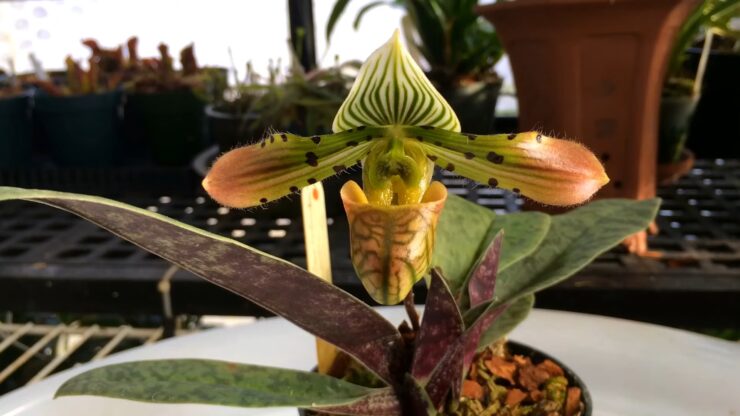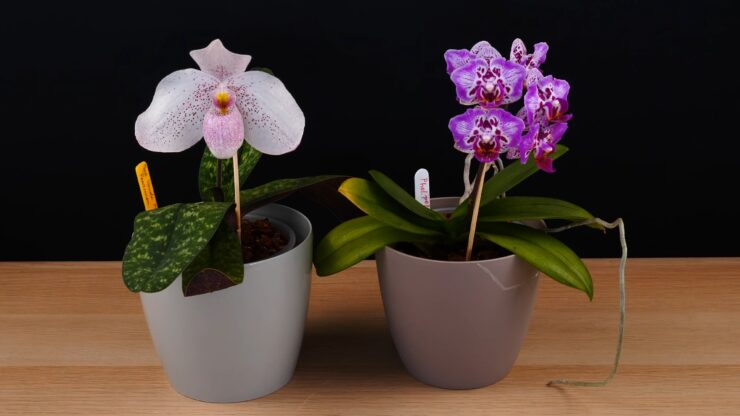If you were born in July, you have a unique birth flower that is just as exotic and beautiful as you are: the July-Paphiopedilum orchid.
This stunning orchid is a popular choice among flower enthusiasts, known for its distinct shape and intricate patterns.
In this article, we’ll take a closer look at the July-Paphiopedilum orchid, its characteristics, and the meanings and symbolism behind it.
The July-Paphiopedilum orchid, also known as the Paphiopedilum or slipper orchid, is native to the Yunnan Province in China, where it grows in rocky cliffs and forests.
It is a type of orchid that belongs to the family of Paphiopedilums, which are commonly referred to as lady slipper orchids due to the distinctive shape of their pouch-like lip.
History Of Orchid
The Paphiopedilum orchid has a rich and fascinating history that dates back centuries. It is also known as the lady slipper orchid, is native to Southeast Asia, and is known for its unique slipper-shaped lip.
It was first discovered in the early 19th century by British botanist William Roxburgh.
Roxburgh named the orchid after Paphos, the city in Cyprus that was home to the ancient Greek goddess Aphrodite.
The orchid’s slipper-shaped lip was thought to resemble the sandals of the goddess.
Throughout the 19th century, the Paphiopedilum orchid became a popular ornamental plant among European aristocrats, who prized its unique beauty and rarity.
Many botanists and horticulturists worked to cultivate new hybrids of the orchid, resulting in a wide range of colors and patterns.
Symbolism and Cultural Significance

In ancient Chinese culture, the Paphiopedilum orchid was a symbol of fertility and prosperity.
It was also believed to have healing properties and was used in traditional medicine to treat various ailments.
In Victorian England, the Paphiopedilum orchid was associated with romantic love and admiration.
It was often given as a gift to express deep affection and devotion to a loved one.
Native American cultures, the symbol of strength and power.
It was used in various ceremonies and was believed to have protective properties.
In modern times, the Paphiopedilum orchid continues to hold significant meaning for many people.
It is often given as a gift to express gratitude, admiration, or sympathy. The orchid’s unique beauty and rarity also make it a symbol of luxury and sophistication.
Medicinal Purposes
While these orchids are primarily known for their unique and beautiful appearance, they have been used in traditional medicine for various purposes.
However, it is important to note that scientific research on the medicinal properties of Paphiopedilum is limited, and some of the traditional uses may not be supported by modern evidence.
Here are a few examples of the reported medicinal uses of Paphiopedilum:
- Antioxidant properties: Some Paphiopedilum species have been found to possess antioxidant properties, which can be helpful in protecting the body from damage caused by free radicals.
- Anti-inflammatory effects: The extracts from certain Paphiopedilum species have been reported to have anti-inflammatory effects, which can be useful in treating conditions like arthritis or other inflammatory disorders.
- Wound healing: Traditionally, some people have used Paphiopedilum extracts to promote wound healing and reduce inflammation in injured areas.
- Respiratory ailments: In traditional Chinese medicine, Paphiopedilum has been used to treat respiratory problems like coughs, asthma, and bronchitis.
- Aphrodisiac: In some traditional medicine systems, Paphiopedilum has been considered an aphrodisiac, which can help improve sexual desire and performance.
- Nervine tonic: Some people believe that Paphiopedilum can help calm the nervous system and alleviate symptoms of stress and anxiety.
Orchid Care and Cultivation – Venus Slipper
Paphiopedilum orchids have leaves that grow in pairs from the plant’s root. These leaves can last for many years, forming a large cluster. Lacking pseudobulbs, they cannot store water and nutrients, so they do not have resting seasons or tolerate extended dry periods. Good drainage is essential for these orchids.
They can be grown from seedlings or propagated through division. Cold-climate varieties tend to have green leaves, while warm-climate varieties often have striped leaves, which are visually appealing even when not in bloom.
Most species are terrestrial, growing in soil, while some are epiphytic or lithophytic. They are relatively easy to grow, and their flowers can last 8 to 10 weeks. Venus Slipper varieties exhibit a wide range of flower sizes and colors.
Temperature for Growing and Caring
Venus Slipper Paphiopedilum orchids are divided into two main groups based on temperature preferences.
Green-leaved varieties typically prefer cool to moderate temperatures, with nighttime temperatures between 13-16°C (55-61°F) and daytime temperatures between 18-24°C (64-75°F).
Striped-leaved varieties prefer moderate to warm temperatures, with nighttime temperatures between 16-18°C (61-64°F) and daytime temperatures between 21-25°C (70-77°F).
In winter, Paphiopedilum orchids can tolerate temperatures as low as 4.4°C (40°F) if there is no frost or water on the leaves. In summer, when temperatures exceed 35°C (95°F), they require humidity and good airflow.
Light for Growing
They do not need direct sunlight. They thrive in bright, indirect light, especially during winter.
If grown in a greenhouse, they require partial shade.
Too little light will prevent blooming, while excessive light can cause leaf yellowing and burning.
Paphiopedilum orchids require moderate light levels, similar to Phalaenopsis or Masdevallia.
A shaded outdoor location or a spot near a window or under four tube lights indoors should suffice.
Watering
Watering is essential for Paphiopedilum orchids year-round, with a frequency of once every 5-7 days in summer and once a week in winter.
It is crucial to keep the plants moist but not waterlogged. Since Paphiopedilum orchids lack water storage, overly dry conditions can damage their roots.
Always water from the top of the pot and avoid flooding.
Clean rainwater is suitable, but filtered water can also be used.
Fertilizing
It’s important to maintain a regular schedule and use diluted fertilizer. Apply a 30-10-10 fertilizer every two weeks in the spring and summer, and once every four weeks in the fall and winter.
Use ¼ teaspoon per week in the summer and once a month in the winter, and flush with water each month to prevent salt buildup.
Humidity And Air Circulation
Are crucial for healthy Paphiopedilum orchids, especially in the summer. This helps to prevent fungal infections and keep the plants from drying out too quickly.
To increase humidity, place the plant on a lightweight gravel tray with 50% moisture content.
When growing indoors, use a tray or dish of water with gravel or wood, but avoid soaking the pot in water.
Repotting
Ideally in the spring. It’s best to use a pot that’s only slightly larger than the current one to allow for growth over the next year.
Repotting can be done even when the plant has buds, as long as the buds aren’t damaged.
Divide or replace pots after flowering, and avoid planting too deep or in a pot that’s too large. Soak the plant in water for 15 minutes to make repotting easier, and bury the plant about 1.27 cm deep.
Control Pests And Diseases
Choose healthy plants and maintain a disease-free environment. Remove weak or infected plants and clean the greenhouse regularly.
While there are no specific pests associated with orchids, fungal infections, and aphids can weaken the plant if left untreated.
Use soap and water to wash them off if caught early, or follow specific instructions for medication if needed.
-
FAQs
How Often Do Paphiopedilum Bloom?
Also known as slipper orchids, typically bloom once a year. The blooming period for these orchids can vary depending on the specific species, growing conditions, and care provided. Some Paphiopedilum species may bloom more frequently, such as every six months, while others might take longer between blooms.
To encourage regular blooming, it is important to provide Paphiopedilum with proper care, including consistent temperatures, adequate humidity, sufficient light, and appropriate watering and fertilizing practices.
Keep in mind that factors such as age, stress, or illness can affect the blooming frequency of Paphiopedilum orchids.
Are They Difficult?
They are often considered easier to grow compared to some other orchid species, and are suitable for beginner and intermediate growers.
However, they do have specific care requirements that need to be met for successful cultivation
Why Are Lady Slippers so Rare?
Lady Slipper orchids (Cypripedium, Paphiopedilum, Phragmipedium, and Selenipedium) are considered rare for several reasons, including their specific growing requirements, habitat loss, and over-collection.
- Specific growing requirements: They have unique and particular growing conditions. Often form a symbiotic relationship with specific fungi found in their native habitats, which help them obtain nutrients. This makes it challenging for them to grow in areas where these fungi are absent.
- Habitat loss: Many Lady Slipper orchids are native to forests or grasslands that have been increasingly destroyed or fragmented due to human activities, such as agriculture, urbanization, and logging. This destruction and alteration of their natural habitats have led to the decline of their populations in the wild.
- Over-collection: The unique beauty and rarity have made them a target for collectors and enthusiasts, leading to over-collection from the wild. This illegal and unsustainable practice has further contributed to the decline of their wild populations.
Efforts are being made to conserve these rare orchids through habitat preservation, responsible propagation, and reintroduction programs. As a result, many Lady Slipper orchids are now protected by law, and it is illegal to collect them from the wild without proper permits.
Related articles:
- What is your birth-orchid? January-Dendrobium
- What is your birth-orchid? December-Cymbidium
- What Is Your Birth-Orchid? October-Cattleya
